#Sutta Nipāta
Explore tagged Tumblr posts
Text

“Radiate boundless love towards the entire world—above, below, and across—unhindered, without ill will, without enmity.”
— The Buddha, Metta Sutta (Sutta Nipāta 1.8)
Nowadays, many fake Buddha quotes circulate, but the authentic teachings of the Buddha are far more powerful and enlightening. This is one of my favorite teachings of the Buddha. This practice transforms us. As we radiate love, we experience the joy of connection, the peace of letting go of resentment, and the profound sense of freedom that comes from living with an open heart. We begin to heal ourselves, and in doing so, we become a source of healing for the world.
Namo Buddhaya
youtube
4 notes
·
View notes
Text

Both the young and the old, the foolish and the wise, all succumb to death.
Everyone will surely meet their end. They are seized by death and depart to the next world, but fathers cannot save their children, nor can relatives save their kin.
Look, even as the grieving relatives watch in endless sorrow, people are taken away one by one like cattle led to the slaughterhouse. (From "The Sutta Nipāta")
3 notes
·
View notes
Quote
🌼🌼🌼Once an illuminating deity asked The Buddha: Which good fortune is the best? Whereto he answered: Not associating with fools, but only with the wise; Honouring only those, who really deserve it; Living in suitable climatic and peaceful regions; Great learning, good discipline, and exact speech; Service to mother and father, support of wife and kids; all these are the supreme good fortune! Giving, and living the just and generous life supporting relatives; Avoidance from all evil behaviour through complete self-control; Abstinence from intoxicating drinks, and drugs causing carelessness; Reverence, devoted faith in the Dhamma, humility, and contentment; Grateful hearing and study of the Dhamma, when one is ready for it: This is the supreme good fortune! Forbearance, patience, and humble yet keen attention, when corrected; Seeing ascetics, recluses, sages, and Bhikkhus, who explain the Dhamma; Living the Noble life, understanding the Noble Truths, and realising quenching; Being unperturbed, when contacted by the manifold phenomena of the world; Having established these exquisite states, one is unconquered everywhere; One goes in safety everywhere — this is verily the supreme good fortune!
Sutta Nipāta 258-269
Dialogues of the Buddha
35 notes
·
View notes
Text

Let your love flow outward through the universe, To its height, its depth, its broad extent, A limitless love, without hatred or enmity.
Then as you stand or walk, Sit or lie down, As long as you are awake, Strive for this with a one-pointed mind; Your life will bring heaven to earth.
–The Sutta-Nipāta
164 notes
·
View notes
Text
givings away
Hawthorne was a hearty devourer of books, and in certain moods of mind it made very little difference what the volume before him happened to be. An old play or an old newspaper sometimes gave him wondrous great content, and he would ponder the sleepy, uninteresting sentences as if they contained immortal mental aliment. He once told me he found 1 givings away in some 2 gestures and beckonings, and givings away of small bunches of early violets 3 licenses, and bridesmaids, and carriages, and givings-away, and 4 (or “givings away”), a term derived from the Chinook jargon word potlatch, “to give” 5 he told me of Lamb’s “givings away” 6 the thefts, the robberies, the givings away. There was no one who would not rather have had all those things in flames 7 these givings away, as well as 8 givings away of [ ] heartsease and rue 9 here are their givings away [ ] all 10 standing there a minute And holding the thrifty man’s book of “givings-away” 11 “givings-away” in one hand, and say: 12 There are these two givings-away. What are the two? 13 across the found time between his givings away to street, or ask favors of 14 the world, with society, with the entourage consisting for him, in its most pressing form of, say, [ ] this challenge, as I have called it, in some way that will sort of meet it without givings-away. These three 15 would Two Givings-Away. 16 You know, we all make deals, I suppose, in terms of how we think about the process of our aging. It’s a series of givings away, a making 17
sources
1 ex James T. Fields, Yesterdays with Authors (1871; 1872) : 62 (same source, different edition, for entry 6 below) 2 ex Jabez D(elano). Hammond. Life and Times of Silas Wright, Late Governor of the State of New York (Syracuse, 1848) : 552 3 ex The Daisydingle Sunday-school (Philadelphia: American Sunday-School Union, 1849) : 22 a “Sunday School Reward Book” 4 ex chapter 12, “A Compact with the Evil One” in “Stoke Dotterell; or, the Liverpool Apprentice,” in The New Monthly Magazine 105 (London, 1855) : 323 5 ex Robert Brown (1842-1895 *), The Races of Mankind : Being a Popular Description of the characteristics, manners and customs of the principal varieties of the human family. Vol. 1 (of 2; 1873) : 75 6 ex James T(homas). Fields (1817-81 *), “‘Barry Cornwall’ and some of his friends,” in Yesterdays with Authors (1871; 1879) : 359 7 ex Cicero’s oration for Sex. Roscius Amerinus, the text closely rendered and illustrated with short notes by an Oxford graduate. (Oxford, 1880) : 9 8 inscrutable OCR misread (snippet view only), Geological Survey of Canada, Report of Progress for the Year (1880?) : 119 9 OCR cross-column misread, involving reviews of two books, Sir John Lubbock, The Pleasures of Life (London, 1887) and James R(ussell). Lowell, Heartsease and Rue (London, 1888), in The Oxford Magazine (May 23, 1888) : 379 on heartsease (or wild pansy (Viola tricolor), also known as Johnny Jump up, &c, &c.) on rue (Ruta graveolens, commonly known as rue, common rue or herb-of-grace...) 10 ex statement of C. W. Bennett, in Hearings before the Committee on Territories of the United States Senate in relation to the Bill (S. 1306) for the local government of Utah Territory, and to provide for the election of certain officers in said territory. (Washington, D.C.; February 11, 1892) 155 11 ex snippet view (only), Commercial West 18 (1910) : 28 12 ex “Thrift,” by Rev. Robert J. Burdette, Pastor Emeritus Temple Baptist Church, Los Angeles, California,in “Savings Bank Section,” Proceedings of the Thirty-Sixth Annual Convention of the American Bankers’ Association... (Held at Los Angeles, California, October 3 to 7, 1910) : 535-538 13 ex “Chapter on Gifts, the thirteenth,” The Anguttara Nikāya of the Sutta Pitaka, Eka Duka and Tika Tika Nipāta; published by The London Pali Text Society in 1885; translated by Edmund Rowland Jayetilleke Gooneratne. (Galle, Ceylon, 1913) : 114 same volume, these errata — for passions read fascination for place read state read any other state for at least read not after cut read off for into read after for does read does not omit, by after blind read man after sandal read wood for error read ignorance after Him insert a full stop 14 ex “In North Carolina’s Calcium Light” (series), Robert Lilly Gray (1877-1945?), “‘Jule’ Carr, the Man—A Pen Picture,” in Sky-land 1:7 (April 1914) : 401-406 a literary magazine promoting a vision of “white” culture and civilization; Julian Shakespeare Carr (1845-1924), was a North Carolina industrialist, philathropist, and Ku Klux Klan supporter; aided (the Methodist and Quaker affiliated) Trinity College, that would become Duke University on Carr’s land in Durham. (much) more at wikipedia aside — it may be that usage of the expression “Sky-land” to denote that region of western North Carolina originated in a travel sketch entitled Land of the Sky (1876) by Christian Reid (1846-1920 *); her characterization was subsequently used to advertise a railroad extension to the area. 15 Henry James, The Ivory Tower (unfinished novel; 1917) : 330 16 OCR cross-column misread/jump, at “Crowns Coronets Courtiers” in The Sketch : A Journal of Art and Actuality 104 (October 9, 1918) :40 weekly magazine, devoted to “high society and the aristocracy” during the years 1893-1959 (wikipedia) list of issues available via hathitrust 17 ex Mark Singer, “David Milch’s Third Act — Despite what dementia has stolen from the cerebral creator of “Deadwood,” it has given his work a new sense of urgency.” The New Yorker (May 27, 2019 issue) : here full passage — “You know, we all make deals, I suppose, in terms of how we think about the process of our aging. It’s a series of givings away, a making peace with givings away. I had thought, as many or most people do, that I was in an earlier stage of givings away than it turns out I am. It’s kind of a relentless series of adjustments to what you can do, in particular the way you can’t think any longer. Your inability to sustain a continuity of focus. And those are accumulated deletions of ability. And you adjust—you’d better adjust, or you adjust whether you want to or not.”
2 notes
·
View notes
Quote
Let no one deceive another or despise anyone anywhere, or through anger or irritation wish for another to suffer.
Sutta Nipāta 1.148
154 notes
·
View notes
Photo

Para Sundarika Bhāradvāja, o brâmane que lhe inquiriu sobre sua linhagem, Xaquiamuni Buda respondeu: “Eu, brâmane, não sou príncipe, nem fazendeiro ou mais nada. Postos mundanos sei todos, sei e minha senda sigo simplesmente tal ninguém: sem lar, trajes peregrinos, sem cabelos por coroa, sereno, eu sigo só, saber-me a origem é vão” Numa ocasião um brâmane insultou o Xaquiamuni Buda dizendo: “Pare, seu impuro! Pare, seu pária!” O Mestre, sem qualquer sentimento de indignação, gentilmente respondeu: “O nascimento não faz alguém pária, O nascimento não faz alguém brâmane; É a ação que faz alguém um pária, é a ação que faz alguém um brâmane”. (Sutta-nipāta, 142). Ou seja, Buda não ficou inerte, ou indiferente, ou isento. Ele se rebelou contra o sistema de castas da Índia. Ele era um Kshatriya, da casta dos guerreiros, e poderia ter ficado nisso. Mas ele agiu - ensinou que a ação pode mudar uma realidade. Portanto, não confundam ahimsa (não violência), wu wei (não ação) e mesmo dhyana paramita (a perfeição da meditação) com indiferença ou inércia. Façam suas escolhas consciente e sabiamente, mas não usem o Darma como argumento ou desculpa para a inércia e a indiferença ao outro, aos seres. Em tempos de sofrimento, vale lembrar o nosso primeiro preceito Mahāyāna de “não fazer mal”. E ficar indiferente ao sofrimento é causar sofrimento. Seria o mesmo que um médico ver alguém com efeito colateral grave de algum medicamento e não se esforçar para substituir ou reduzir a dose porque “é assim mesmo”. E tenho dito. Desperte para sua própria vida, desfrute sua vida 🙏🏼 e busquemos práticas corretas! No Darma, Yakusan https://www.instagram.com/p/CVh_MO_FJyY/?utm_medium=tumblr
0 notes
Text
This is just my opinion, and I don't know enough about buddhism to make an informed one, but the three poisons thing is interchangeable between all three girls.
They all had/have an unhealty attachment to eachother, ignorance to the situations of their world at large, and an aversion to facing their problems. They each obviously have one poison they specifically fell prey to, and the temples seemed to have helped with that if barely, but the point of a poison is to do damage undetected and if they only work on one flaw without acknowledging others... well what happened, happened.
Now again this is just personal opinion but I feel the girls NEED the powers if they're going to face The Night, and the bad feeling Anne's powers have could be anything from them being inherently bad, to it being a side effect of the not fully charged stone and even that the powers are meant to be used together.
I like the idea and possibility that it all has happened before in some sort of cycle, or that there have been multiple "Stars" throught the years, and that our trio needs to do something different to finally put an end to it.
Also I downloaded the Sutta Nipāta and thinking about the Rhinoceros Sutra.
I was going through this recurring background elements post when I realized something.
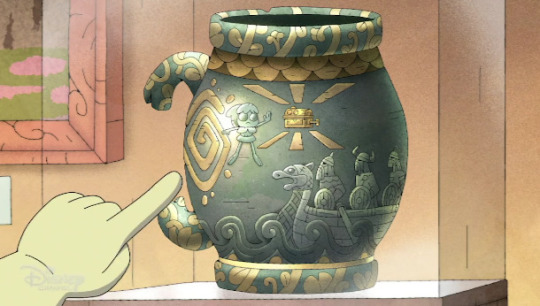
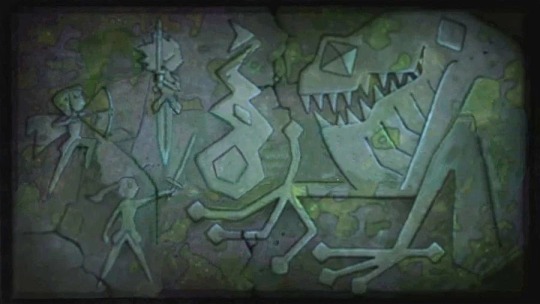
It’s very likely that these are depictions, or at least stylizations, of the same event: a frog presenting three humans with an ancient power.
We, or at least I, have been assuming that the mural in the opening and in the First Temple was the girls fighting the Night, but with last episode’s revelation that the Night is most likely an olm, that no longer makes sense to me. First of all, because the creature depicted on the mural is clearly a frog, or at the very least a toad; secondly, because olms are creatures of darkness, yet this creature seems to be giving out the fire (aka the calamity power) instead of shielding itself from it -
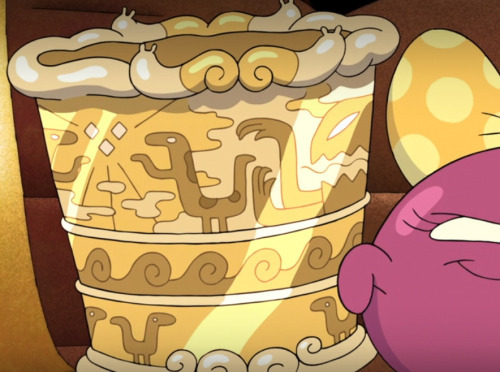
- like the creature on the right (also looking more like an olm) is doing here.
I’m also associating the calamity power with fire, and more broadly with light, because the colors of the three gems (red, green and blue) are the primary components of light, and because light is quite obviously the only thing that can defeat the Night (the prophecy even refers to the three humans as “three stars burning bright”).
As an aside, light also works on the weird creatures in the basement, though I’m not sure if and how they are connected to the Night:

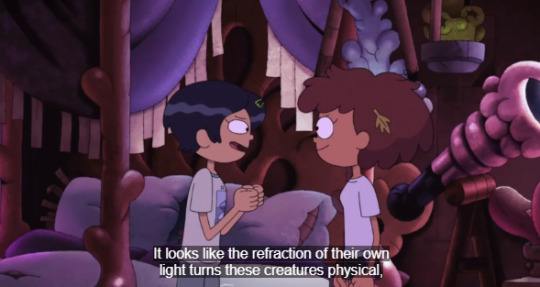
The only difference between the picture on the vase and the mural in the intro is in the humans. The three people the pink frog encountered were obviously Vikings, whereas the people on the mural look a lot like Anne, Sasha and Marcy, and might or might not be them. Even assuming that the people in the intro are our girls, we know there have been other humans in Amphibia before them but after Viking times, because of the walkman in Wax Museum.
So my question is: is it possible that the girls aren’t the end-all-be-all of this prophecy, that their arrival wasn’t special and foreseen, that they’re just three among many who’ve tried?

Think about it. If three humans, and only three (those being Anne, Sasha and Marcy specifically), were ever meant to come to Amphibia and defeat the Night, Valeriana would have known for sure here that Anne was one of them. Instead, she only seems to realize after Anne passes her temple challenge and proves herself worthy.

Note what she says, too: “We have been waiting for someone like you”, not “We have been waiting for you”. There was no telling it would be Anne, because she wasn’t the first human to try; but Valeriana seems convinced she’ll be the one to succeed.
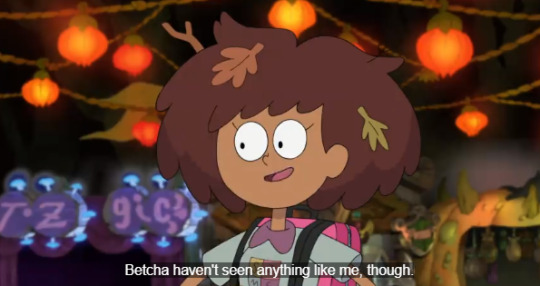

This also explains why the temples felt so ill-fitted to the girls: because they weren’t made with them in mind. They couldn’t take into account their individual strengths and weaknesses, or the lessons they needed to hear at that point in their character arcs, because they weren’t built to guide them specifically.

In The First Temple, Andrias mentions that the prophecy is being “undone”. I wondered why it was worded like that - how does one even undo a prophecy? Shouldn’t he want to prevent it, instead? And then I realized - the word choice only makes sense if the prophecy is already ongoing. You can’t prevent something that’s been happening for a thousand years, but you can put a stop to it - in Andrias’s case, by taking the calamity powers out of the equation and making sure they’re not used against him.
But then, you say, what happened to the previous humans who’ve tried fighting the Night? Did they die? Did they reincarnate?
Not exactly.

It’s already been pointed out that the Vikings on the vase look like mossmen, and there are theories connecting Anne to the mossmen - perhaps, as a glimpse into what she will become if she can’t control her powers, or if she allows them to overwhelm her. We also know the mossmen are, for some reason, connected to bellflowers (and is that an olm statue, too?), which Anne was wearing in The Dinner.
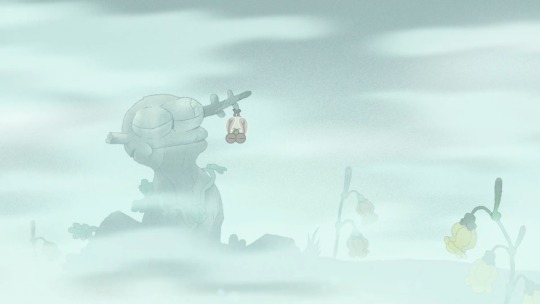

So ultimately, while we’re dealing with a cycle, it’s most likely not a reincarnation cycle. I figured I should mention it, because I did look into a few key concepts of Theravada Buddhism which Matt Braly could’ve been inspired by - but I advise you to take this with a grain of salt. Matt’s Thai heritage and culture is undeniably at the heart of this story, but not being Thai/Buddhist/Asian myself, I don’t want to misconstrue things and will ask if anyone with a deeper knowledge on the subject would like to pitch in or correct me on anything.
What I was able to figure out is that some Asian cultures believe in a cycle of continuous birth, death, and rebirth called samsara, which involves all matter and all living creatures.
Existence in samsara is painful and unsatisfactory, ever-changing but ever the same, and the only way out of the cycle is by achieving nirvana through the extinction of the three fires/three poisons/three unwholesome roots (these are described as ignorance, attachment, and aversion, and while they don’t quite seem to line up with wit, heart and strength or even stand in opposition to them specifically, I found the recurrence of the number three and of the fire imagery noteworthy all the same). With nirvana comes, among other things, full acceptance of the impermanence of reality.
Similar concepts and beliefs in cyclical patterns are sometimes represented, especially in Western culture, through the ouroboros -

- which looks awfully like this guy right here, on Andrias’s belt.
We know Amphibia is, at its core, a story about change. Even though I don’t think literal reincarnation is involved, one could argue that a set of three people being taken from their homeworld, trying to defeat a threat, and ultimately being consumed by the powers they were supposed to wield against it, leaving a whole new set of people to replace them, could fulfill the same metaphorical purpose.
Why and how this happens in the first place isn’t clear to me, and again I’m not sure if Matt has been inspired by Buddhism at all - but it sure would be fitting if this show about accepting change ended with our characters finally breaking out of a painful, seemingly endless thousand-year-old cycle.
780 notes
·
View notes
Photo

“Yathā ahaṃ tathā ete; yathā ete tathā ahaṃ.” Atthānaṃ upamaṃ katvā, na haneyya na ghātaye.
“As I am, so are others; as others are, so am I.“ Having thus indentified self and others, harm no one nor have them harmed. --Sutta Nipāta 3.710
1 note
·
View note
Photo

Great Rivers "Learn this from the waters: in mountain clefts and chasms, loud gush the streamlets, but great rivers flow silently." - Sutta Nipāta 3.725 I am almost certainly a streamlet, regardless of whether I open my mouth or not.
0 notes
Text

Daily Words of the Buddha for June 12, 2017
Dhamme ca ye ariyapavedite ratā anuttarā te vacasā, manasā kammunā ca. Te santisoraccasamādhisaṇṭhitā, sutassa paññāya ca sāramajjhagū.
Those who are devoted to the Dhamma made known by the Noble Ones are unsurpassed in speech, thought and action. They are established in peace, gentleness and concentration, and have reached the essence of learning and wisdom.
Sutta Nipāta 3.332
7 notes
·
View notes
Quote
One should not kill a living being, nor cause it to be killed, nor should one incite another to kill. Do not injure any being, either strong or weak, in the world. Pāṇaṃ na hane na ca ghātayeyya, na cānujaññā hanataṃ paresaṃ, sabbesu bhūtesu nidhāya daṇḍaṃ. Ye thāvarā ye ca tasā santi loke.
Sutta Nipāta 2.396
32 notes
·
View notes
Note
Sam, I seem to remember someone asking for advice about getting into the suttas beyond the Dhammapada a while ago, but can't find the answer. So, where's a good starting point?
I recommend starting with Udāna, Itivuttaka, Sutta Nipāta, Theragāthā & Therīgāthā. They are small and easy to read. If I had to choose one, I'd say the Sutta Nipāta.
9 notes
·
View notes
Text
物質的形態を捨てよ
ピンギヤよ。物質的な形態があるが故に、人々が害われるのを見るし、物質的な形態があるが故に、怠る人々は (病いなどに) 悩まされる。ピンギヤよ。それ故に、そなたは怠ることなく、物質的形態を捨てて、再び生存状態にもどらないようにせよ。
『スッタ・ニパータ』第5章第17節第1121句、中村元訳。 Sutta Nipāta. V, 17, 1121. c. 3c BCE.
0 notes